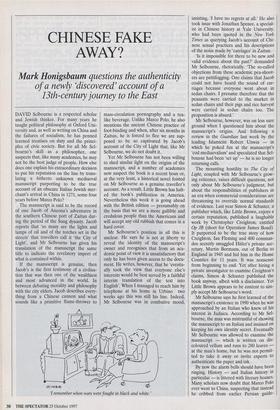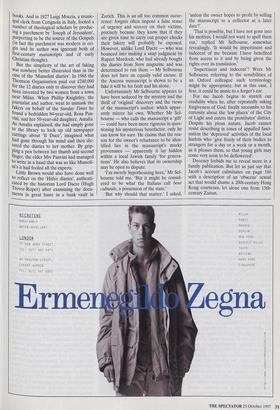CHINESE FAKE AWAY?
Mark Honigsbaum questions the authenticity
of a newly 'discovered' account of a 13th-century journey to the East
DAVID Selboume is a respected scholar and Jewish thinker. For many years he taught political philosophy at Oxford Uni- versity and, as well as writing on China and the failures of socialism, he has penned learned treatises on duty and the princi- ples of civic society. But for all Mr Sel- bourne's skill as a philosopher, one suspects that, like many academics, he may not be the best judge of people. How else does one explain his extraordinary decision to put his reputation on the line by trans- lating a hitherto unknown mediaeval manuscript purporting to be the true account of an obscure Italian Jewish mer- chant's arrival in China in 1271, some four years before Marco Polo?
The manuscript is said to be the record of one Jacob of Ancona's adventures in the southern Chinese port of Zaitun dur- ing the period of the Sung dynasty. Jacob reports that 'so many are the lights and lamps of oil and of the torches set in the streets' that travellers call it 'the City of Light', and Mr Selbourne has given his translation of the manuscript the same title to indicate the revelatory import of what is contained within.
If the manuscript is genuine, then Jacob's is the first testimony of a civilisa- tion that was then one of the wealthiest and most advanced in the world. In between debating morality and philosophy with the city elders, Jacob describes every- thing from a Chinese cannon and what sounds like a primitive flame-thrower to mass-circulation pornography and a tea- like beverage. Unlike Marco Polo, he also mentions the ancient Chinese practice of foot-binding and when, after six months in Zaitun, he is forced to flee we are sup- posed to be so captivated by Jacob's account of the City of Light that, like Mr Selbourne, we do not doubt it.
Yet Mr Selbourne has not been willing to shed similar light on the origins of the manuscript, and a number of academics now suspect the book is a recent hoax or, at the very least, a historical novel foisted on Mr Selbourne as a genuine traveller's account. As a result, Little Brown has halt- ed the book's publication in America. Nevertheless this week it is going ahead with the British edition — presumably on the basis that we are a more gullible and credulous people than the Americans and will accept any old rubbish that comes in a hard cover.
Mr Selboume's position in all this is unclear. He says he is not at liberty to reveal the identity of the manuscript's owner and recognises that from an aca- demic point of view it is unsatisfactory that only he has been given access to the docu- ment. He writes, however, that he 'eventu- ally took the view that everyone else's interests would be best served by a faithful interim translation of the text into English'. When I managed to reach him by telephone at his home in Urbino two weeks ago this was still his line. Indeed, Mr Selbourne was in combative mood, `I remember when wars were fought in black and white.' insisting, 'I have no regrets at all.' He also took issue with Jonathan Spence, a special- ist in Chinese history at Yale University, who had been quoted in the New York Times as querying Jacob's account of Chi- nese sexual practices and his descriptions of the noise made by 'carriages' in Zaitun.
`Is it impossible for there to be new and valid evidence about the past?' demanded Mr Selbourne, rhetorically. 'The so-called objections from these academic pea-shoot- ers are pettifogging. One claims that Jacob could not have heard the sound of car- riages because everyone went about in sedan chairs. I presume therefore that the peasants were carried to the market in sedan chairs and their pigs and rice harvest were carried in sedan chairs too. The proposition is absurd.'
Mr Selboume, however, was on less sure ground when I questioned him about the manuscript's origins. And following a review in the Guardian last week by the leading Islamicist Robert Unwin — in which he poked fun at the manuscript's `cod mediaevalism' and speculated that Sel- bourne had been 'set up' — he is no longer returning calls.
The mounting hostility to The City of Light, coupled with Mr Selbourne's grow- ing reticence, raises difficult questions, not only about Mr Selbourne's judgment, but about the responsibilities of publishers in an era when commercial considerations are threatening to override normal standards of evidence. Last year Simon & Schuster, a publisher which, like Little Brown, enjoys a certain reputation, published a laughable work by Christopher Creighton, entitled Op JB (short for Operation James Bond). It purported to be the true story of how Creighton, Ian Fleming and 400 comman- dos secretly smuggled Hitler's private sec- retary, Martin Bormann, out of Berlin to England in 1945 and hid him in the Home Counties for 11 years. It was nonsense from beginning to end. Yet after hiring a private investigator to examine Creighton's claims, Simon & Schuster published the book anyway, albeit with a disclaimer. Yet Little Brown appears to be content to sim- ply accept Mr Selbourne's word.
Mr Selbourne says he first learned of the manuscript's existence in 1990 when he was approached by an Italian who knew of his interest in Judaica. According to Mr Sel- bourne, the man was mistrustful of showing the manuscript to an Italian and insisted on keeping his own identity secret. Eventually Mr Selbourne was allowed to examine the manuscript — which is written on dis- coloured vellum and runs to 280 leaves at the man's home, but he was not permit- ted to take it away or invite experts to authenticate the paper and ink.
By now the alarm bells should have been ringing. History — and Italian history in particular — is littered with literary hoaxes. Many scholars now doubt that Marco Polo ever went to China, suspecting that instead he cribbed from earlier Persian guide- books. And in 1927 Luigi Moccia, a munic- ipal clerk from Cerignola in Italy, fooled a number of theological scholars by produc- ing a parchment by 'Joseph of Jerusalem', Purporting to be the source of the Gospels (in fact the parchment was modern in ori- gin and its author was ignorant both of first-century manuscripts and of early Christian thought). But the simplicity of the art of faking was nowhere better illustrated than in the Case of the 'Mussolini diaries'. In 1968 the Thomson Organisation paid out £240,000 for the 12 diaries only to discover they had been invented by two women from a town near Milan. When Philip Knightley, the journalist and author, went to unmask the fakers on behalf of the Sunday Times he found a bedridden 84-year-old, Rosa Pan- vim, and her 50-year-old daughter, Amalia. As Amalia explained, she had simply gone to the library to look up old newspaper cuttings about 'Il Duce', imagined what had gone through his mind and then dic- tated the diaries to her mother. By grip- Ping a pen between her thumb and second finger, the elder Mrs Panvini had managed to write in a hand that was so like Mussoli- ni's it had fooled all the experts. Little Brown would also have done well to reflect on the 'Hitler diaries', authenti- cated by the historian Lord Dacre (Hugh Trevor-Roper) after examining the docu- ments in great haste in a bank vault in Zurich. This is an all too common occur- rence: forgers often impose a false sense of urgency and secrecy on their victims, precisely because they know that if they are given time to carry out proper checks their fakery will probably be exposed. However, unlike Lord Dacre — who was bounced into making a snap judgment by Rupert Murdoch, who had already bought the diaries from Stern magazine and was determined to run them — Mr Selbourne does not have an equally valid excuse. If the Ancona manuscript is shown to be a fake it will be his fault and his alone.
Unfortunately Mr Selbourne appears to have been seduced by the mystery and the thrill of 'original' discovery and the views of the manuscript's author, which appar- ently mirror his own. Whether Mr Sel- bourne — who calls the manuscript a 'gift' — could have been more rigorous in ques- tioning his mysterious benefactor, only he can know for sure. He claims that the rea- son for the owner's reluctance to be iden- tified lies in the manuscript's murky provenance — apparently it lay hidden within a local Jewish family 'for genera- tions'. He also believes that its ownership may be open to dispute.
`I'm merely hypothesising here,' Mr Sel- bourne told me. 'But it might be consid- ered to be what the Italians call bene culturale, a possession of the state.'
`But why should that matter,' I asked, `unless the owner hopes to profit by selling the manuscript to a collector at a later date?'
`That is possible, but I have not gone into his motives, I would not want to spell them out,' replied Mr Selbourne, somewhat revealingly. 'It would be impertinent and indecent of me because I have benefited from access to it and by being given the rights over its translation.'
`Impertinent and indecent'? Were Mr Selbourne referring to the sensibilities of an Oxford colleague such terminology might be appropriate, but in this case, I fear, it could be music to a forger's ear.
For me Jacob begins to stretch our credulity when he, after repeatedly asking forgiveness of God, finally succumbs to his curiosity about the low places' of the City of Light and enters the prostitutes' district. Despite his pious nature, Jacob cannot resist describing in tones of appalled fasci- nation the 'depraved' activities of the local harlots who 'give freely of their bodies to strangers for a day or a week or a month, as it pleases them, so that young girls may come very soon to be deflowered'.
Decency forbids me to reveal more in a family publication. But let us just say that Jacob's account culminates on page 166 with a description of an 'obscene' sexual act that would shame a 20th-century Hong Kong courtesan, let alone one from 13th- century Zaitun.



















































































 Previous page
Previous page